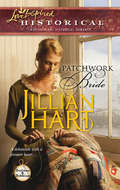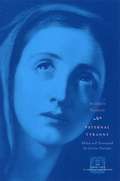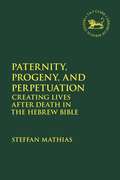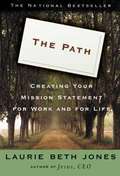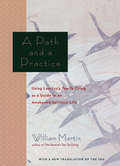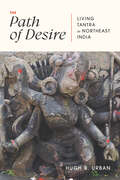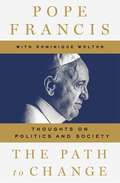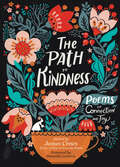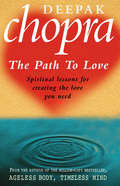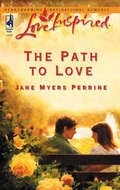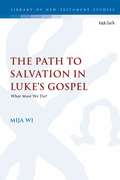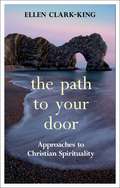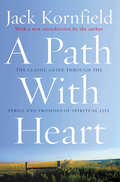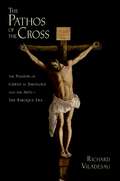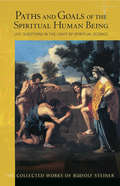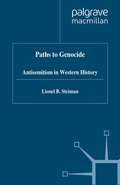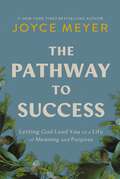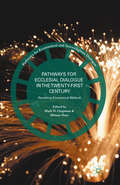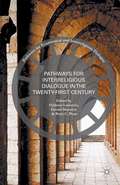- Table View
- List View
Patchwork Bride: Gingham Bride Her Patchwork Family (Buttons and Bobbins #2)
by Jillian HartAt last, Meredith Worthington is returning to Angel Falls, Montana. Now that she's escaped the matchmaking and scheming of her East Coast finishing school, she can follow her dream of becoming a teacher. And perhaps get to know Shane Connelly, the intriguing new wrangler on her father's ranch….
Paternal Tyranny (The Other Voice in Early Modern Europe)
by Arcangela TarabottiSharp-witted and sharp-tongued, Arcangela Tarabotti (1604-52) yearned to be formally educated and enjoy an independent life in Venetian literary circles. But instead, at sixteen, her father forced her into a Benedictine convent. To protest her confinement, Tarabotti composed polemical works exposing the many injustices perpetrated against women of her day. Paternal Tyranny, the first of these works, is a fiery but carefully argued manifesto against the oppression of women by the Venetian patriarchy. Denouncing key misogynist texts of the era, Tarabotti shows how despicable it was for Venice, a republic that prided itself on its political liberties, to deprive its women of rights accorded even to foreigners. She accuses parents of treating convents as dumping grounds for disabled, illegitimate, or otherwise unwanted daughters. Finally, through compelling feminist readings of the Bible and other religious works, Tarabotti demonstrates that women are clearly men's equals in God's eyes. An avenging angel who dared to speak out for the rights of women nearly four centuries ago, Arcangela Tarabotti can now finally be heard.
Paternal Tyranny (The Other Voice in Early Modern Europe)
by Arcangela TarabottiSharp-witted and sharp-tongued, Arcangela Tarabotti (1604-52) yearned to be formally educated and enjoy an independent life in Venetian literary circles. But instead, at sixteen, her father forced her into a Benedictine convent. To protest her confinement, Tarabotti composed polemical works exposing the many injustices perpetrated against women of her day. Paternal Tyranny, the first of these works, is a fiery but carefully argued manifesto against the oppression of women by the Venetian patriarchy. Denouncing key misogynist texts of the era, Tarabotti shows how despicable it was for Venice, a republic that prided itself on its political liberties, to deprive its women of rights accorded even to foreigners. She accuses parents of treating convents as dumping grounds for disabled, illegitimate, or otherwise unwanted daughters. Finally, through compelling feminist readings of the Bible and other religious works, Tarabotti demonstrates that women are clearly men's equals in God's eyes. An avenging angel who dared to speak out for the rights of women nearly four centuries ago, Arcangela Tarabotti can now finally be heard.
Paternal Tyranny (The Other Voice in Early Modern Europe)
by Arcangela TarabottiSharp-witted and sharp-tongued, Arcangela Tarabotti (1604-52) yearned to be formally educated and enjoy an independent life in Venetian literary circles. But instead, at sixteen, her father forced her into a Benedictine convent. To protest her confinement, Tarabotti composed polemical works exposing the many injustices perpetrated against women of her day. Paternal Tyranny, the first of these works, is a fiery but carefully argued manifesto against the oppression of women by the Venetian patriarchy. Denouncing key misogynist texts of the era, Tarabotti shows how despicable it was for Venice, a republic that prided itself on its political liberties, to deprive its women of rights accorded even to foreigners. She accuses parents of treating convents as dumping grounds for disabled, illegitimate, or otherwise unwanted daughters. Finally, through compelling feminist readings of the Bible and other religious works, Tarabotti demonstrates that women are clearly men's equals in God's eyes. An avenging angel who dared to speak out for the rights of women nearly four centuries ago, Arcangela Tarabotti can now finally be heard.
Paternity, Progeny, and Perpetuation: Creating Lives after Death in the Hebrew Bible (The Library of Hebrew Bible/Old Testament Studies)
by Steffan MathiasThis book offers a fresh perspective on the importance of progeny and perpetuation of the family line in the Hebrew tradition. Steffan Matthias argues that the Hebrew bible depicts failing to protect the transmission of the family line as both a failure in the social order, a threat to the afterlife, and a failure in masculinity, leading to the eradication of the name and memory of the man and the destruction of the household. Using the work of Pierre Bourdieu, as well as anthropological and gender-critical insights, Matthias reassess pertinent texts which respond to the threat of men dying without children, such as levirate marriage (Deut 22:5-10) or the erection of monuments (Isa 56:5-8).Themes such as death, burial and memorial, identity, covenant, name, genealogy, property, seed and sexuality, rather than being treated as separate parts of social or family life, are critically assessed in light of each other. Matthias instead illustrates how they form part of the same discourse of social reproduction, in which the integrity of the family is protected and passed down from father to son in generations of descendants. Paternity, Progeny, and Perpetuation raises profound questions regarding the subtle ways texts that respond to this threat of social annihilation – the destruction of the father and his line - reinforce social boundaries and construct men as transmitters of identity and women as submissive counterparts.
The Path: Creating Your Mission Statement for Work and for Life
by Laurie Beth JonesIndividuals and companies have been learning what history has demonstrated all along -- that people or groups with carefully defined missions have always led and surpassed those who have none. Yet the process of outlining that mission statement has been, up to now, an arduous one that all too few have committed the time, energy, and resources to undertake. In The Path, best-selling author Laurie Beth Jones provides inspiring and practical advice to lead readers through every step of both defining and fulfilling a mission. With more than ten years' experience in assisting groups and individuals, Jones offers clear, step-by-step guidance that can make writing a mission statement take a matter of hours rather than months or years. Rich with humor, exercises, mediations, and case histories, The Path is essential reading for anyone seeking a lighter, clearer way in the world.
A Path and a Practice: Using Lao Tzu's Tao Te Ching as a Guide to an Awakened Spiritual Life
by William MartinThe Tao Te Ching-one of the most loved and widely translated books in human history-has appeared in countless English-language versions. But no modern translation has yet captured the essential thrust of Lao Tzu's work as a practical guide to living an awakened life. Now William Martin, whose acclaimed previous reinterpretations of the Tao (for parents, couples, and elders) have introduced or reacquainted this classic text to thousands of readers, strikingly translates the Tao's eighty-one chapters to uniquely address someone on a Tao-or path-with a practice. Martin frames his new translation with two illuminating, groundbreaking sections: "A Path," which introduces the Tao's nonlinear construction and explains how it works its themes; and "A Practice," which provides practical guidance for readers exploring each of the Tao's themes in depth. Martin's genius in this new translation uncovers how directly the Tao speaks to readers on or about to embark on a spiritual journey.
A Path and a Practice: Using Lao Tzu's Tao Te Ching as a Guide to an Awakened Spiritual Life
by William MartinThe Tao Te Ching-one of the most loved and widely translated books in human history-has appeared in countless English-language versions. But no modern translation has yet captured the essential thrust of Lao Tzu's work as a practical guide to living an awakened life. Now William Martin, whose acclaimed previous reinterpretations of the Tao (for parents, couples, and elders) have introduced or reacquainted this classic text to thousands of readers, strikingly translates the Tao's eighty-one chapters to uniquely address someone on a Tao-or path-with a practice. Martin frames his new translation with two illuminating, groundbreaking sections: "A Path," which introduces the Tao's nonlinear construction and explains how it works its themes; and "A Practice," which provides practical guidance for readers exploring each of the Tao's themes in depth. Martin's genius in this new translation uncovers how directly the Tao speaks to readers on or about to embark on a spiritual journey.
The Path of Desire: Living Tantra in Northeast India
by Hugh B. UrbanA provocative study of contemporary Tantra as a dynamic living tradition. Tantra, one of the most important religious currents in South Asia, is often misrepresented as little more than ritualized sex. Through a mixture of ethnography and history, Hugh B. Urban reveals a dynamic living tradition behind the sensationalist stories. Urban shows that Tantric desire goes beyond the erotic, encompassing such quotidian experiences as childbearing and healing. He traces these holistic desires through a series of unique practices: institutional Tantra centered on gurus and esoteric rituals; public Tantra marked by performance and festival; folk Tantra focused on magic and personal well-being; and popular Tantra imagined in fiction, film, and digital media. The result is a provocative new description of Hindu Tantra that challenges us to approach religion as something always entwined with politics and culture, thoroughly entangled with ordinary needs and desires.
The Path of Desire: Living Tantra in Northeast India
by Hugh B. UrbanA provocative study of contemporary Tantra as a dynamic living tradition. Tantra, one of the most important religious currents in South Asia, is often misrepresented as little more than ritualized sex. Through a mixture of ethnography and history, Hugh B. Urban reveals a dynamic living tradition behind the sensationalist stories. Urban shows that Tantric desire goes beyond the erotic, encompassing such quotidian experiences as childbearing and healing. He traces these holistic desires through a series of unique practices: institutional Tantra centered on gurus and esoteric rituals; public Tantra marked by performance and festival; folk Tantra focused on magic and personal well-being; and popular Tantra imagined in fiction, film, and digital media. The result is a provocative new description of Hindu Tantra that challenges us to approach religion as something always entwined with politics and culture, thoroughly entangled with ordinary needs and desires.
The Path to Change: Thoughts on Politics and Society
by Pope Francis Dominique WoltonPope Francis has thoroughly re-engaged the Catholic Church with the modern world, by tackling the difficult and urgent questions that we face as a civilization, in order to illuminate the path to change. French sociologist Dominique Wolton interviewed Pope Francis regularly over the course of a year, and their open, warm dialogue builds a detailed picture of how Pope Francis became the most popular leader the Catholic Church has ever seen.The Pope’s clarity, humility and humanity are brought to the fore by Dominique Wolton’s engaging and relevant questions. As well as revealing fascinating insights into his early life, in The Path to Change Pope Francis freely addresses the major issues of our time: peace and war, politics and religion, globalization and cultural diversity, fundamentalism and secularism, Europe and migrants, ecology, family, time, trust and joy.
The Path to Kindness: Poems of Connection and Joy
by Edited by James CrewsFollowing the success and momentum of his anthology How to Love the World (93,000 copies in print), James Crews's new collection, The Path to Kindness, offers more than 100 deeply felt and relatable poems from a diverse range of voices including well-known writers Julia Alvarez, Marie Howe, Ellen Bass, Naomi Shihab Nye, Alberto Ríos, Ross Gay, and Ada Limón, as well as new and emerging voices. Featured Black poets include January Gill O&’Neil, Tracy K. Smith, and Cornelius Eady. Native American poets include Kimberly Blaeser, Joy Harjo (current U.S. Poet Laureate), and Linda Hogan. The collection also features international voices, including Canadian poets Lorna Crozier and Susan Musgrave. Presented in the same perfect-in-the-hand format as How to Love the World, the collection includes prompts for journaling and exploration of selected poems, a book group guide, bios of all the contributing poets, and stunning cover art by award-winning artist Dinara Mirtalipova. A foreword by Danusha Laméris, along with her popular poem "Small Kindnesses," is also included. This publication conforms to the EPUB Accessibility specification at WCAG 2.0 Level AA.
Path To Love: Spiritual Lessons for Creating the Love You Need (Large Print Ser.)
by Dr Deepak ChopraIn this groundbreaking personal development book, influential teacher and physician Deepak Chopra, explores how our hearts have lost their centre and why love so often falls short of filling a deep, aching need within us. He also explains how we can find the love we long for, one which is rich and meaningful, satisfying and lasting - by restoring to love its missing element: spirituality. In presenting the long-forgotten, timeless laws of love, together with practical suggestions for bringing them into our lives, Deepak Chopra shows us how to transform our lives forever - and the lives of those whom we love.
The Path To Love (Mills And Boon Love Inspired Ser.)
by Jane Myers PerrineI found God. I know, I'd said it once before, to get out of trouble, but this time it's true.
The Path to Salvation in Luke's Gospel: What Must We Do? (The Library of New Testament Studies #607)
by MiJa WiThis book investigates Luke's message of salvation in relation to socio-economic issues, and thus concerns salvation of the rich as well as the poor. With a narrative reading of Luke's Gospel built on careful examination of its socio-economic context, it demonstrates that Luke's message of salvation is best understood as: 1) Divine mercy which champions the cause of the poor and redresses the injustice of the world, 2) Its human embodiment, and 3) Divine reward promised to those who enact mercy.Wi argues that Luke's question of 'what must we do?' juxtaposes salvation with 'doing', posing interesting questions with respect to the salvation of the rich. This volume highlights good news to the poor in terms of divine mercy and justice, shows that the reception of divine mercy calls for practices, which embody it, and above all clarifies Luke's notion of salvation of the rich which will happen as participation in the salvation of the poor. Wi's conclusion challenges its readers by asking the question along with Luke's audience: What must we do?
The Path to Salvation in Luke's Gospel: What Must We Do? (The Library of New Testament Studies #607)
by MiJa WiThis book investigates Luke's message of salvation in relation to socio-economic issues, and thus concerns salvation of the rich as well as the poor. With a narrative reading of Luke's Gospel built on careful examination of its socio-economic context, it demonstrates that Luke's message of salvation is best understood as: 1) Divine mercy which champions the cause of the poor and redresses the injustice of the world, 2) Its human embodiment, and 3) Divine reward promised to those who enact mercy.Wi argues that Luke's question of 'what must we do?' juxtaposes salvation with 'doing', posing interesting questions with respect to the salvation of the rich. This volume highlights good news to the poor in terms of divine mercy and justice, shows that the reception of divine mercy calls for practices, which embody it, and above all clarifies Luke's notion of salvation of the rich which will happen as participation in the salvation of the poor. Wi's conclusion challenges its readers by asking the question along with Luke's audience: What must we do?
The Path to Your Door: Approaches to Christian Spirituality
by Ellen Clark-KingWritten in response to a need expressed by Spiritual Directors, Retreat Leaders and teachers on introductory courses to Christian spirituality for an engaging and readable introduction to the subject, The Path to Your Door provides an accessible and well-researched introduction to themes within the Christian spiritual tradition. In a highly readable fashion it introduces the reader to some of the key themes in classic and contemporary Christian experience and allows them to engage with the material for themselves through the use of varied spiritual exercises. The Path to Your Door is an invitation to an on-going journey of spiritual exploration, grounded in the Christian tradition but encouraging each reader to find their own path and discover their own unique language of prayer.
The Path to Your Door: Approaches to Christian Spirituality
by Ellen Clark-KingWritten in response to a need expressed by Spiritual Directors, Retreat Leaders and teachers on introductory courses to Christian spirituality for an engaging and readable introduction to the subject, The Path to Your Door provides an accessible and well-researched introduction to themes within the Christian spiritual tradition. In a highly readable fashion it introduces the reader to some of the key themes in classic and contemporary Christian experience and allows them to engage with the material for themselves through the use of varied spiritual exercises. The Path to Your Door is an invitation to an on-going journey of spiritual exploration, grounded in the Christian tradition but encouraging each reader to find their own path and discover their own unique language of prayer.
A Path With Heart: The Classic Guide Through The Perils And Promises Of Spiritual Life
by Jack KornfieldPerhaps the most important book yet written on meditation, the process of inner transformation, and the integration of spiritual practice into our Western way of life, A Path With Heart brings alive the possibilities of inner peace, wholeness and the achievement of happiness. Written by a teacher, psychologist and meditation master of international renown, this is a warm, inspiring and, above all, practical book. Its gentle Buddhist wisdom will guide you through the ups and downs of contemporary living, such as addiction, psychological and emotional healing, problems with relationships and the difficulties of achieving a balanced life of simplicity.
The Pathos of the Cross: The Passion of Christ in Theology and the Arts-The Baroque Era
by Richard ViladesauThe Baroque period was in some senses the beginning of modern Western scientific and intellectual culture-the early budding of the Enlightenment. In the light of a new scientific and historical consciousness, it saw the rise of deism and the critique of traditional forms of Christianity. Secular values and institutions were openly or surreptitiously replacing the structures of traditional Christian society. At the same time, there was also a trend of religious renewal and the reaffirmation of tradition. In Roman Catholicism, the Patristic, medieval, and Tridentine paradigms were subsumed into a powerful Counter-Reformation spirituality, propagated not only in books, treatises, and sermons, but also in music and in the works of what was arguably the last period of great sacred art. It inspired masters like Bernini, Reni, Rubens, Velázquez, Zurbarán, and Van Dyck. In the Protestant traditions, the Reformation movement found affective expression in new forms of music produced by Monteverdi, Scarlatti, Handel, Telemann, and Bach. The title, The Pathos of the Cross, points to a major aspect of the spirituality of this period: a dramatic portrayal of the events of Christ's passion meant to provoke an emotional response from the viewer and listener. Many works of the period retain their emotional pull centuries later, even though the theology they represent has been challenged and frequently rejected. This volume traces the ways in which Roman Catholic and Protestant theologies of the period proclaimed the centrality of the cross of Christ to human salvation. In a parallel movement, it illustrates how musical and artistic works of the period were both inspired and informed by these theologies, and how they moved beyond them in an aesthetic mediation of faith.
Paths and Goals of the Spiritual Human Being: Life Questions in the Light of Spiritual Science
by Rudolf SteinerSpeaking to audiences in Denmark, Germany and France, Rudolf Steiner discusses a wide range of topics: from positive and negative human soul capacities, true self-knowledge and karma, to changes in human consciousness, from ancient times to the modern era – all in the context of the incarnation of Christ on earth.The lectures illustrate the diversity of Steiner’s approach when speaking to different audiences. Reflecting on the polymath Novalis, for example, he is urgent about the responsibility of spiritual science to help humanity awaken to the new age. A few months later, talking of Hegel and deploring the fact that an interest in spiritual matters often fails to be accompanied by an equal interest in logical thought, Steiner uses a dispassionate, philosophical tone. But throughout the lectures he is consistent in his view that spiritual science does not reject conventional science. Trained philosophical thinking leads to different conclusions than materialism, he says, but there is nothing in the field of spiritual science that need be rejected by rigorous scientific thought.Although the lectures were given to a variety of audiences, ideas recur from different perspectives and in different contexts, with strong thematic links binding them together. These include the relationship between philosophy and science; the nature of clairvoyance; Christ’s presence in the etheric realm; reincarnation and karma; the mystery drama The Portal of Initiation; Christmas and its symbols; and the transformation of consciousness that occurred when Christ incarnated physically on earth.In the final lectures, Rudolf Steiner speaks inspiringly about the Christmas festival, contrasting the feeling of inwardness that people used to experience with the hectic cultural environment of modern cities. However, this does not lead Steiner to be nostalgic about the past. Rather, he states, we should seek to recreate a mood of inwardness in a new way, appropriate to our modern age and consciousness. These lectures give us the tools to bring such a contemporary spiritual approach to our lives.
Paths to Genocide: Antisemitism in Western History
by L. SteimanPaths to Genocide examines the development of antisemitism from the beginnings of Christianity, through the Middle Ages, Reformation, Enlightenment and nineteenth century liberalism, nationalism and racism to the Holocaust. Focusing on major periods, places and problems in the history of European civilization, the book highlights historical contexts as it shows how religion, science, and socioeconomic forces all played a role in the evolution of antisemitism to its genocidal climax.
The Pathway to Success: Letting God Lead You to a Life of Meaning and Purpose
by Joyce MeyerRenowned Bible teacher and #1 New York Times bestselling author Joyce Meyer shows readers how to realign their perspective on success to conform with God&’s vision for the kind of life that brings us true purpose and lasting joy. The world tells us that having a good job, owning your own business, money, fame, and influence are all important for a successful life. If we don&’t have them, we feel like a failure. But even when we achieve them, we still end up unhappy, unfulfilled, or lonely. God wants us to be successful, but His definition of success is not the same as the world's definition. The truth is, God&’s way of achieving the dreams and desires that truly fulfill us and bring genuine joy to our lives is very different—and that is what we need. In The Pathway to Success, you will discover a deeper understanding of what it means to seek success God's way. Through her practical, relatable insights based on God&’s Word, beloved Bible teacher Joyce Meyer reveals how to actively pursue the keys to true, lasting success. Full of rich encouragement and timeless wisdom, The Pathway to Success will allow you to refocus your life and fulfill your God-given destiny as you walk out the purpose He&’s planned for you.
Pathways for Ecclesial Dialogue in the Twenty-First Century: Revisiting Ecumenical Method (Pathways for Ecumenical and Interreligious Dialogue)
by M. Chapman Miriam HaarThis volume identifies a myriad of obstacles standing in the way of dialogue both within churches and between churches and then move on to discuss how these obstacles might be dissolved or circumvented. The contributors explore all the ways through which ecclesial dialogue can be re-energized and adapted for a new century.
Pathways for Inter-Religious Dialogue in the Twenty-First Century (Pathways for Ecumenical and Interreligious Dialogue)
by Peter C. Phan Gerard Mannion Vladimir LatinovicWithout question, inter-religious relations are crucial in the contemporary age. While most dialogue works on past and contemporary matters, this volume takes on the relations among the Abrahamic religions and looks forward, toward the possibility of real and lasting dialogue. The book centers upon inter-faith issues. It identifies problems that stand in the way of fostering healthy dialogues both within particular religious traditions and between faiths. The volume's contributors strive for a realization of already existing common ground between religions. They engagingly explore how inter-religious dialogue can be re-energized for a new century.
